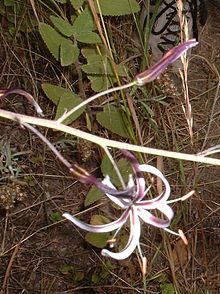- Chlorogalum
-
Soap plant 
Wavy-leafed Soap Plant (Chlorogalum pomeridianum) Scientific classification 
Kingdom: Plantae clade: Angiosperms clade: Monocots Order: Asparagales Family: Asparagaceae Subfamily: Agavoideae Genus: Chlorogalum
KunthSpecies Chlorogalum angustifolium
Chlorogalum grandiflorum
Chlorogalum parviflorum
Chlorogalum pomeridianum
Chlorogalum purpureumThe Soap Plants, Soaproots or Amoles are the genus Chlorogalum of flowering plants. Less common names for them include Soap Lilies. They are endemic to western North America, from Oregon to Baja California, and are mostly found in California.
The Soap Plants grow as perennial plants, from a bulb, more or less elongated depending on the species. The bulbs can be white or brown, and in most species are very fibrous. The leaves grow from the base of the plant. The flowers are borne on a long central stem, and appear to have six rather separate petals (not all are petals in the technical sense). There are 6 stamens, which are rather prominent in most species.
The placement of the genus Chlorogalum has varied considerably. In the APG III system, followed here, it is placed in the family Asparagaceae, subfamily Agavoideae, based on molecular systematics evidence.[1] Until the 1980s, it was generally treated in the Lily family, Liliaceae, in the order Liliales, and conservative taxonomic sources such as ITIS still put it there. It has also been placed in its own family, Chorogalaceae, or in a group within the hyacinth family Hyacinthaceae (now Scilloideae), in the order Asparagales. Phylogenetic studies based on molecular evidence (e.g. Pfosser and Speta 1999), suggested that, along with Camassia, Chlorogalum seemed to be most closely related to the genera such as Agave and Anthericum.
Five species are currently classified in the genus. All except the Wavy-leafed Soap Plant, Chlorogalum pomeridianum, have rather restricted distributions, with little overlap. The Wavy-leafed Soap Plant, however, has a range that virtually encompasses those of all other members of the genus, and is the most common of them.
- Narrow-leaf Soap Plant, Chlorogalum angustifolium, found in the inner north Pacific Coast Ranges of California and southern Oregon and the Sierra Nevada foothills
- Red Hills Soaproot, Chlorogalum grandiflorum, found in the north and central Sierra Nevada foothills
- Small-flowered Soaproot Chlorogalum parviflorum, found in the south coastal region of California, south of Santa Barbara, and into Baja California
- Wavy-leafed Soap Plant, Chlorogalum pomeridianum, found anywhere in California except the higher Sierra Nevada and the deserts, and also in south-western Oregon
- Purple Amole, Chlorogalum purpureum, found in the Outer South Coast Ranges of California, south of Monterey Bay and north of Santa Barbara
Uses
Many of California's Native American tribes traditionally used soaproot, which contains saponin, as a fish poison. They would pulverize the roots, mixing in water to create a foam, and then add the suds to a stream. This would kill or incapacitate the fish, which could be gathered easily from the surface of the water. Among the tribes using this technique were the Lassik, the Luiseño, the Yuki, the Yokut, the Chilula, the Wailaki, the Miwok, the Kato, the Mattole, the Nomlaki and the Nishinam.[2]
The abundant, tough external fibers sheathing the bulbs of C. pomeridinaum var. pomeridianum were used by native peoples of California to craft brushes and combs.[citation needed]
External links
References
- ^ Stevens, P.F. (2001 onwards), Angiosperm Phylogeny Website: Asparagales: Agavoideae, http://www.mobot.org/mobot/research/apweb/orders/asparagalesweb.htm#Agavaceae
- ^ Campbell, Paul (1999). Survival skills of native California. Gibbs Smith. pp. 433. ISBN 9780879059217. http://books.google.com/books?id=qSRLW5ziVFAC&pg=PA433&lpg=PA433&dq=soaproot+fish+poison&source=bl&ots=Gt1n3gSQms&sig=QtWjKzozUVxrrECNNAJFPF8DTJo&hl=en&ei=Gkp2TtDCDIzTiALamtmzAg&sa=X&oi=book_result&ct=result&resnum=2&ved=0CCAQ6AEwAQ#v=onepage&q=soaproot%20fish%20poison&f=false.
- Pfosser, M. and Speta, F. (1999) Phylogenetics of Hyacinthaceae based on plastid DNA sequences. Annals of the Missouri Botanical Garden, 86, 852-875.
Categories:- Asparagaceae genera
- Flora of California
- Agavoideae
Wikimedia Foundation. 2010.

